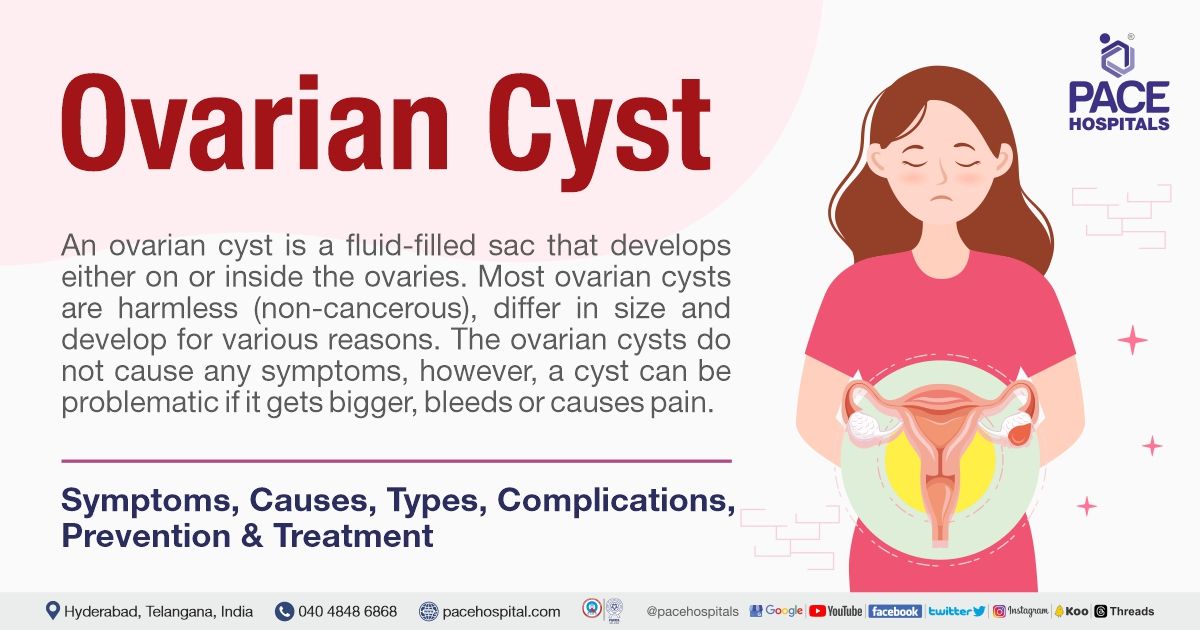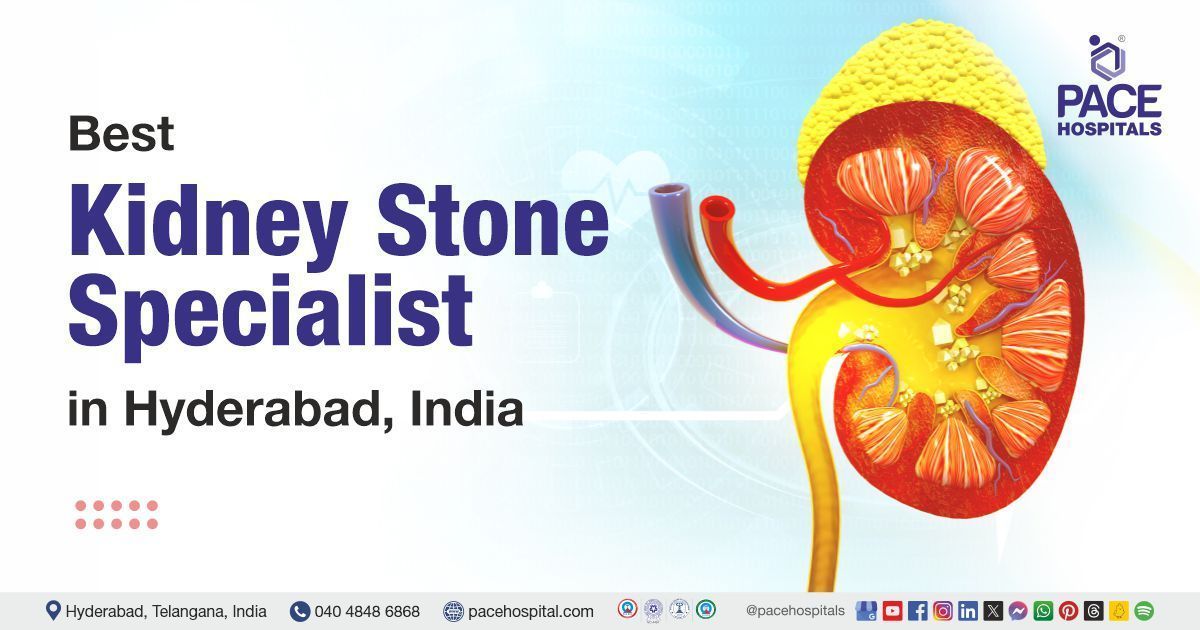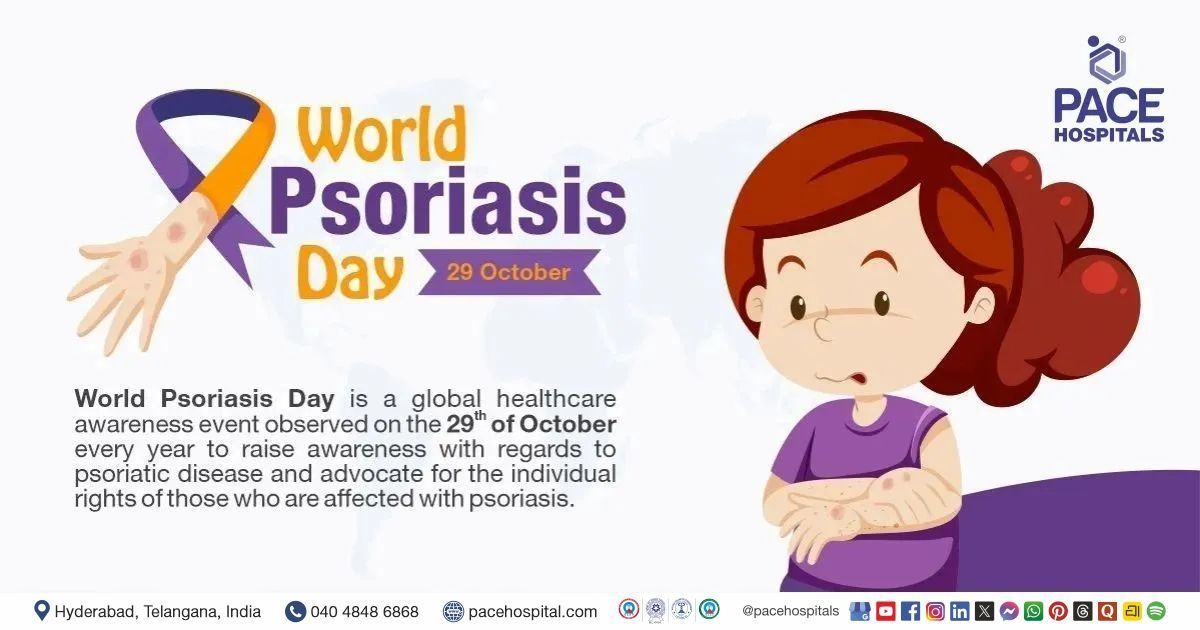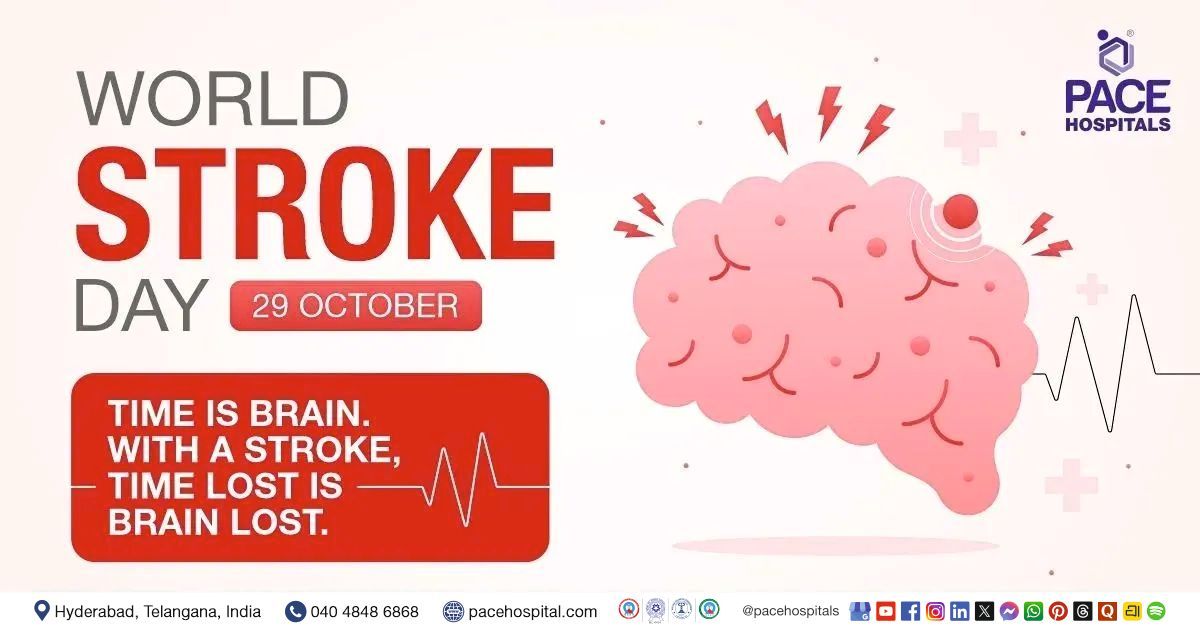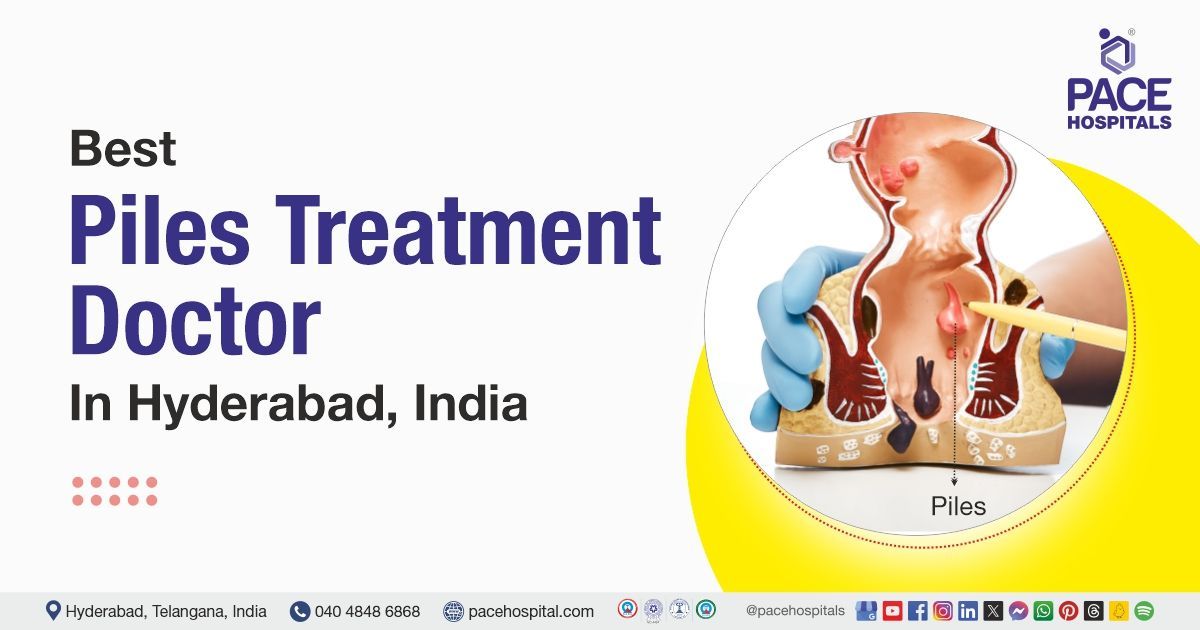Ovarian cyst - Symptoms, Causes, Types, Complications, Prevention & Treatment
Ovarian cyst meaning
An ovarian cyst is a fluid-filled sac that develops either on or inside the ovaries (a part of the female reproductive system). If the cyst of the ovary is filled with fluid, it is called a simple ovarian cyst, which is more common at any age, whereas a cyst is filled with blood or solid material, it is referred to as a complex ovarian cyst, which is less common and more likely to become cancerous.
Cyst meaning
Cysts are closed sacs that contain liquid, semi-solid, gaseous, or other substances. Usually, they are caused by infection, injury, or other medical issues. Cysts are typically harmless (benign) but may need treatment if complications occur.
However, most ovarian cysts are non-cancerous (benign ovarian cyst) and harmless, but they can differ in size and develop for various reasons. The, ovarian cysts do not cause any symptoms, however, a cyst can be problematic if it gets bigger, bleeds or causes pain.
- They are very common in women of reproductive age and usually form during ovulation, but their occurrence decreases after menopause.
- They often resolve on their own without causing any noticeable symptoms or requiring treatment. But in some cases, they can indicate the underlying medical condition and may need removal.
Preventing the ovarian cysts completely is not possible. However, specific measures must be taken to decrease the risk, such as maintaining a healthy weight, using contraception (birth control) and getting regular pelvic examinations.
Incidence of ovarian cyst
Ovarian cyst epidemiology or the actual number of ovarian cyst cases in women is not known (uncertain) because many people don’t have any noticeable symptoms and are never diagnosed.
Out of 100, every four women will be hospitalized for ovarian cysts by the age they turn 65. In a study of 335 healthy women aged 24 to 40, without symptoms, 8% had an adnexal lesion. An adnexal cyst is a fluid-filled or solid growth that forms around the ovaries, fallopian tubes and surrounding connective tissue.
2.5 out of every 100 postmenopausal women have a simple unilocular adnexal cyst, which is typically benign and may resolve spontaneously.
In a large survey of 33,739 women premenopausal (before menopause) and postmenopausal (after menopause) women, nearly half of the women had an adnexal cyst on transvaginal ultrasound. Among those with the cysts, about 63.2 or 9,958 showed the resolution of the cyst on ultrasounds.
Most of the cysts are benign ovarian cysts (non-cancerous). However, a type called mature cystic teratomas or dermoids is a non-cancerous (benign ovarian cyst) that accounts for over 10% of all ovarian growths.
Para ovarian cysts occur in the broad ligament between the fallopian tube and ovary, which are relatively uncommon and account for only 5–20% of all adnexal masses.
Ovarian cysts are the most common tumour in infants (babies) and foetuses (unborn babies). More than 30 out of every 100 infants and foetuses will have ovarian cysts.
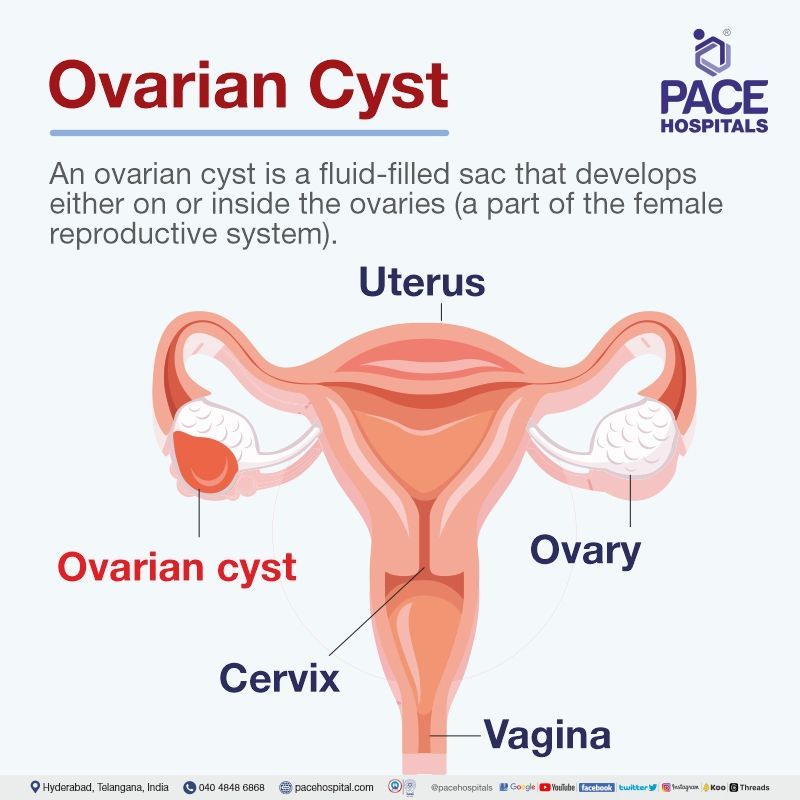
Types of ovarian cysts
Women contain two ovaries located on either side of the uterus in the lower abdomen as part of the reproductive system. When a cyst develops on the left ovary, it is referred to as a left ovarian cyst, whereas if it forms on the right ovary, it is referred to as a right ovarian cyst. Sometimes, the cysts, called bilateral ovarian cysts, may develop on both sides of the ovaries.
There are different types of ovarian cysts, but they can be broadly categorized into two main groups:
- Functional ovarian cysts
- Pathological cysts
1. Functional ovarian cysts: These are the most common type harmless (benign ovarian cyst) and short-lived cysts that often develop as part of the menstrual cycle and indicate a sign of healthy ovarian function. Generally, these cysts shrink over time, usually within two months (60 days), without any specific treatment.
There are two subtypes of functional cysts:
- Follicular cysts: As a part of a woman's menstrual cycle, the follicle (small sac in the ovary) releases an egg every month for fertilization(ovulation). Follicular cysts happen when a follicle fails to release an egg. Instead, it fills with fluid and continues to grow bigger.
- Corpus luteum cysts: After ovulation, a follicle transforms into the corpus luteum (temporary endocrine structure). In some cases, fluid collects in the corpus luteum and may develop as cysts.
In some cases, both follicular and corpus luteal cysts can potentially turn into hemorrhagic cysts, which may occur due to ovulation rather than any medical condition. Other haemorrhagic ovarian cyst causes include follicle rupture, injury to ovary, some fertility drugs or anticoagulant medications. Haemorrhagic ovarian cyst treatment includes bed rest, pain medication and surgery (if the cyst is large and causing severe symptoms.
2. Pathological cysts: These cysts are rare and can develop due to various medical conditions. Examples include:
- Dermoid cysts: The dermoid cyst types are sac-like growths, that develops on the ovaries, contain the cells that can form various tissue types in the human body, including skin, teeth, hair and even brain tissue. Ovarian dermoid cyst symptoms are not noticeable until the cysts become large. Dermoid cyst causes include infections, gene mutations, developmental abnormalities
- Endometriomas or chocolate cysts: These are cysts filled with endometrial tissue, the same tissue that a woman bleeds (shed) each month during menstruation. Chocolate cyst symptoms include painful and crampy periods, pelvic pain not related to menstruation, infertility for some woman.
- Cystadenomas: They develop on the surface of the ovary and are filled with thin and watery or thicker and mucous-like fluid.
- Serous cystadenomas: It contains one or more cysts on the surface of the ovary. These are typically filled with a clear, thin, and watery fluid.
- Mucinous cystadenomas: These are composed of multiple glands and cysts that are filled with a thick, mucous-like fluid.
- Polycystic Ovary Syndrome (PCOS): It is a hormonal disorder that affects women and leads to the development of multiple small cysts on the ovaries and causing the ovaries to enlarge.
- Ovarian cancer cysts: Unlike the conditions mentioned above, ovarian cancer cysts (tumours) are not fluid-filled sacs. Instead, they are solid masses made up of cancer cells.
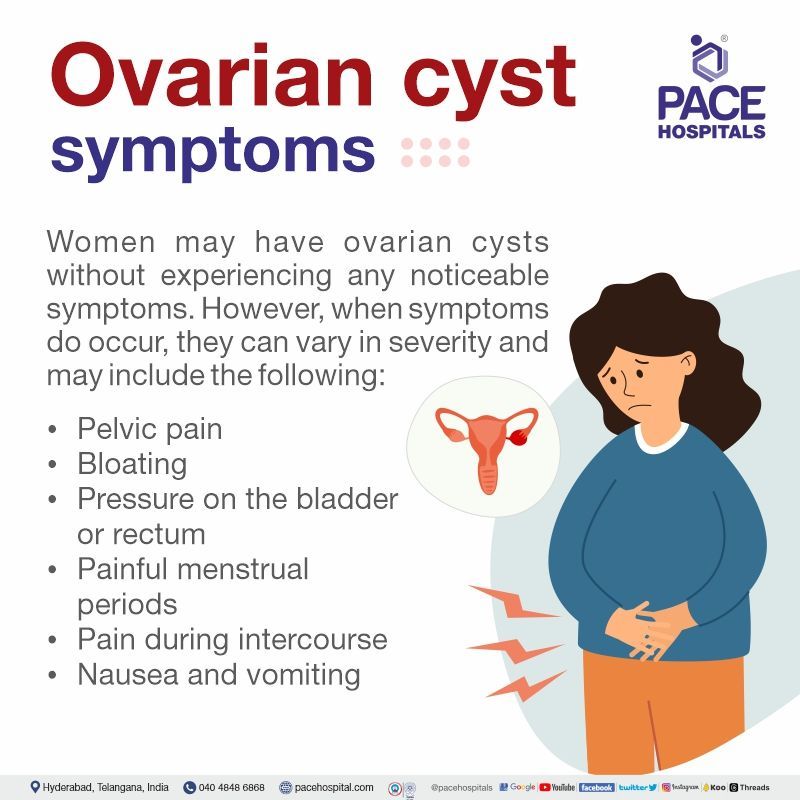
Ovarian cyst symptoms
Women may have ovarian cysts without experiencing any noticeable symptoms. Usually, an ovarian cyst may cause symptoms when it ruptures, grows very large, twists (twisted ovarian cyst), or blocks the blood supply to the ovaries. However, when symptoms do occur, they can vary in severity and may include the following:
- Pelvic pain (ovary pain): Ovarian cysts most commonly cause pain or pressure in the lower abdomen, ranging from dull, aching sensation to sharp and severe discomfort that may be constant or come and go. Ruptured ovarian cyst symptoms includes severe and sharp ovary pain. Hemorrhagic ovarian cyst symptoms often include sudden, sharp or severe pelvic pain on the side where the cyst is located.
- Bloating: Some women with ovarian cysts may experience pressure, swelling, a feeling of fullness in the lower abdomen or abdominal bloating, which may be persistent or come and go.
- Pressure on the bladder or rectum: Large ovarian cysts may push the nearby organs, such as the rectum or bladder, causing increased urinary frequency, pain when urinating or constipation and changes in bowel habits.
- Painful Menstrual Periods: Menstrual cycle problems can occur if the ovarian cyst produces sex hormones, which cause the lining of the uterus to thicken, where the cysts associated with endometriosis are known as endometriomas or chocolate cyst (endometriosis ovarian cyst) can become large and painful, leading to a painful period.
- Pain during intercourse: Rupture of cysts can cause sudden onset of sharp pain and typically occurs during sexual intercourse due to the pressure of the penis. It usually occurs due to large cysts.
- Nausea and Vomiting: Twisting (torsion) or rupturing of an ovarian cyst (twisted ovarian cyst) causes symptoms such as nausea and vomiting along with abdominal pain.
- Unexplained Weight Gain: Cysts, especially those associated with polycystic ovary syndrome (PCOS), can be linked to weight gain and difficulty losing weight.
- Difficulty Getting Pregnant: Having an ovarian cyst does not usually affect fertility. However, one condition called polycystic ovary syndrome (PCOS), which involves numerous small cysts, which can reduce the chances of becoming pregnant for a woman.
- Cancerous cyst symptoms include abnormal bloating and swelling, pelvic pain, changes in bowel habits, feeling full quickly and abnormal menstrual bleeding.
Ovarian cyst causes
The exact cause of most ovarian cysts is idiopathic (unknown). The most probable reason for ovarian cyst formation depends on several factors, including the regularity of the menstrual cycle. In premenopausal women, the most common causes of ovarian cysts include:
- Hormonal imbalance: A woman may develop ovarian cysts when there is an imbalance in the hormones (hormonal changes) that regulate the menstrual cycle. Common hormonal imbalances that can lead to ovarian cysts include:
- Polycystic ovary syndrome (PCOS): It is a medical condition that is characterised by the overproduction of hormones such as testosterone and androstenedione by the ovary. PCOS can cause the ovaries to form multiple small cysts.
- Hypothyroidism: An underactive or overactive thyroid may also affect the ovulation process. Due to the similarity between the alpha subunit of thyroid-stimulating hormone (TSH) and hCG, hypothyroidism may stimulate ovarian and cyst growth.
- Endometriosis: Women with endometriosis, especially in the advanced stages of the disease, can develop an ovarian cyst called an endometrioma cyst or "chocolate cyst".
- Pregnancy (ovarian cyst pregnancy): As a natural process of the woman, an ovarian cyst develops on the ovary in early pregnancy to support it until the placenta forms. It may sometimes persist on the ovary until later in the pregnancy.
- Severe pelvic infections: Extreme pelvic infections can spread to the ovaries and fallopian tubes of the woman, forming pus-filled cysts close to the ovaries and fallopian tubes.
- Medications: Some fertility drugs and hormone replacement therapy (HRT) can raise the risk of developing ovarian cysts.
- Genetics: Genetic factors may be the reason for the formation of some ovarian cysts. Women with a family history of ovarian cancer have a higher risk of developing them.
- Cancer: Ovarian cysts are a relatively uncommon(rare) result of cancer in premenopausal women -who have not yet been through menopause. Less than 1% of new growths on or around the ovary are related to cancer of the ovary.
In postmenopausal women (who no longer have menstrual periods), the following are the most common causes of ovarian cysts:
- Non-cancerous growth
- Fluid collection in the ovary
- Cancer: New growths on or around the ovary are more likely to be malignant (cancerous) than in those who menstruate.
Ovarian cyst risk factors
Multiple factors may increase the risk of ovarian cysts. The following are some of the risk factors might be associated with ovarian cyst development:
- Age and reproductive Stage
- Hormonal imbalance
- Pregnancy
- Infertility treatment
- Maternal gonadotropins
- Cigarette smoking
- Tubal ligation
- Some medications
- Age and Reproductive Stage: Ovarian cysts can develop in women of all ages. However, they are more common during the reproductive years (age of 20 -44) due to the production of endogenous hormones. These hormones regulate the ovulation process and can lead to the development of follicular or corpus luteum cysts in the ovaries. As women age, the risk of developing other, various, less common types of ovarian cysts also rises.
- Hormonal imbalance: A woman is more susceptible to ovarian cysts when there is an imbalance in the hormones (hormonal changes) that regulate the menstrual cycle.
- Pregnancy: In pregnancy, a woman may develop ovarian cysts between weeks 13 and 26 (second trimester) when HCG levels are at their highest. Ovarian cysts may sometimes persist on the ovary until later in the pregnancy.
- Infertility treatment: Patients undergoing ovulation induction for infertility may have the risk of developing ovarian cysts as part of ovarian hyperstimulation syndrome.
- Maternal gonadotropins: The use of maternal gonadotropins may lead to the development of foetal and neonatal ovarian cysts.
- Cigarette smoking: Smokers have a high risk of developing functional ovarian cysts. It is possible that the risk of smoking could increase if an individual has a lower body mass index (BMI).
- Tubal ligation: Tubal ligation sterilizations are associated with functional cysts. So, the patient who underwent tubal ligation has the risk of developing cysts.
- Medications: Some medications can cause benign functional ovarian cysts, but discontinuing them can resolve cysts.
Family history of ovarian cysts, endometriosis condition, pelvic infections and cancer may also increase the risk of ovarian cysts. Not all women develop ovarian cysts with these risk factors, while some women may develop ovarian cysts without apparent risk factors.
Ovarian cyst complications
While most ovarian cysts are benign and resolve on their own without treatment. However, some can lead to complications. The complications associated with this condition can depend on factors such as the type, size, and location of the cyst and whether it stays asymptomatic or causes symptoms.
Possible complications of the ovarian cyst include:
- Rupture: The ruptured ovarian cyst complications might vary based on its type, if the ovarian cysts ruptures or bursts, especially larger ones, can cause sudden and severe abdominal pain, but in case of rupturing of the hemorrhagic ovarian cyst (a type of ovarian cyst that is filled with blood), it can cause the blood to leak into surrounding tissues and This condition often requires immediate medical attention.
- Ovarian torsion (twisted ovarian cyst): If a cyst grows bigger than 5 cm, it can cause complete or partial twisting of the ovary, leading to obstruction of blood flow to the ovary, which causes severe pelvic pain along with nausea and vomiting, and these ovarian torsion symptoms often require emergency surgery.
- Cancerous cyst: Ovarian cysts after menopause are more likely to be malignant (cancerous). Very occasionally, an ovarian cyst can be an early form of ovarian cancer.
- Interference with pregnancy: Certain types of ovarian cysts, such as endometriomas or PCOS, may interfere with ovulation implantation of a fertilized egg and affect fertility or complicate pregnancy.
- Infection: Sometimes, an ovarian cyst can become infected, filled with bacteria and pus, leading to a tubo-ovarian abscess. If the bursting of abscess occurs inside the body, there is a risk of developing septicaemia (blood poisoning).
- Peritonitis: Sometimes, the bursting of ovarian cysts, may lead to the condition called peritonitis (Inflammation of the membrane that lines the abdominal wall).
Ovarian cyst complications during pregnancy
Usually, ovarian cysts may occur during pregnancy to support it until the placenta forms. It is common for a woman to develop at least one ovarian cyst during their lifetime. However, sometimes, it may persist on the ovary until later in pregnancy. Most ovarian cysts are harmless but become problematic if they continue to develop throughout the pregnancy. Ovarian cysts might cause complications such as sudden and severe pelvic pain and interference with childbirth if they rupture or twist.
Ovarian cyst diagnosis
The diagnostic evaluation of an ovarian cyst usually involves a combination of medical history, physical examination, and diagnostic tests. Here's an overview of the steps involved in diagnosing ovarian cysts:
- Medical History
- Imaging Studies - Ultrasound, Transvaginal ultrasound, Pelvic MRI
- Blood Tests - Complete blood count, Pregnancy testing, Cancer antigen 125 (CA 125)
Other tests:
A gynaecologist may perform other tests to confirm cysts, which include:
- Urinalysis
- Swab test
- Laparoscopy
Ovarian cyst treatment
Ovarian cyst treatment without surgery: There are various treatment options available, but ultimately, management (treatment) depends on factors that include the patient's age, menopausal status, the ovarian cyst size, and whether the cyst has characteristics suspicious of malignancy.
In general, there are several approaches to managing ovarian cysts:
- Watchful Waiting (Observation): Most ovarian cysts in reproductive age are follicular or corpus luteum cysts, which are harmless, have no long-term medical consequences, and naturally disappear or resolve within two or three months, even though they may cause pain by rupturing. If the cyst is functional, a gynaecologist may recommend the watchful waiting (wait and see) approach for a few weeks or months to see if the cyst is resolving on its own or not with frequent monitoring.
- Pain Management: If an ovarian cyst is causing any discomfort or pain, Nonsteroidal anti-inflammatory drugs (NSAIDs) and narcotic analgesics may be recommended to relieve the symptoms.
- Oral Contraceptives (Birth Control Pills): Sometimes, a gynaecologist may recommend the oral contraceptive pills (OCPs) to protect against the development of functional ovarian cysts. The OCPs reduce the amount of hormones produced in the ovaries and prevent ovulation. For recurrent functional cysts or to prevent new ones from forming, oral contraceptives (birth control pills) may be prescribed.
- Cyst Drainage: Large or painful cysts can be drained with a needle or small incision, but this may not be a long-term solution as the cyst can be refilled.
The steps mentioned above will be applicable under ovarian dermoid cyst treatment and simple ovarian cyst treatment is not required for all patients because simple cysts resolve on their own.
A gynaecologist may recommend removing the cyst if it:
- doesn’t resolve after three months
- grows, especially if it's larger than 6cm
- causes clinical symptoms
- twisted or ruptured
- may be malignant (cancerous)
Ovarian cyst surgery
If an ovarian cyst is getting bigger and causing symptoms, surgery will be needed to remove it. Sometimes, gynaecologists suggest removing the cyst even if it is not causing any symptoms. Removing the cyst also reduces the risk of the cyst becoming malignant (cancerous) later on. The type of surgery may depend on the ovarian cyst size and how it seems (appears) on the ultrasound.
The ovarian cyst removal surgery involves two main types, such as
Laparoscopy: The ovarian cyst laparoscopic surgery is a minimally invasive procedure where the gynaecologist inserts a camera and surgical tools through small incisions in the patient's abdomen to view and access the reproductive organs and pelvic cavity to remove the cyst from the ovary.
A gynaecologist performs the following techniques to remove the cysts by using laparoscopy:
- Laparoscopic ovarian cystectomy: Few cysts can be removed from the ovary without removing it completely.
- Laparoscopic oophorectomy: Sometimes, the cyst is removed with an ovary
Laparotomy: It is an open surgery that involves a larger incision in the abdomen to access the ovaries and fallopian tubes to remove the cyst. After removing the cyst, incision will be closed with stitches. This approach is typically reserved for large cysts, complex, or suspected cancer cases.
Ovarian cyst prevention
It is not possible to prevent ovarian cysts, but one can reduce the risk of developing ovarian cyst by taking specific measures:
- Regular health checkups: Scheduling routine checkups with a gynaecologist may help monitor reproductive health and detect any cysts early.
- Maintain a Healthy Weight: Obese people may have a high risk of developing ovarian cysts. Therefore, maintaining a healthy weight with diet and exercise can reduce this risk.
- Eating a healthy diet. Eating proper and healthy food can help to maintain a healthy weight and reduce the risk of developing other chronic conditions, such as heart disease, stroke, and type 2 diabetes.
- Exercise Regularly: Regular (physical activity) exercise promotes physical and hormonal health and well-being.
- Avoiding smoking and excessive alcohol consumption: Smoking and excessive alcohol consumption can affect the health of the ovaries and raise the risk of ovarian cysts.
- Limit excessive hormone use: Limit the use of hormone therapies as they can influence ovarian cyst formation.
Additional tips for ovarian cyst prevention
- Eat plenty of fruits and vegetables: Fruits and vegetables are prosperous in antioxidants and nutrients that protect cells from damage.
- Limit the intake of processed foods and sugary drinks: Processed foods and sugary drinks are high in calories, sugar and unhealthy fats. Overeating of these foods can cause obesity and other health problems, including ovarian cysts.
- Get enough sleep: Good sleep promotes the overall health of the person. When a person does not get sufficient sleep, it increases the production of cortisol (stress hormone), which can increase the risk of developing some health conditions.
- Manage Stress: Stress from a long time may affect the woman's hormone levels and increase the risk of ovarian cysts. Addressing stress also plays a crucial role in preventing the ovarian cyst.
Difference between Ovarian cyst and PCOS (polycystic ovarian syndrome)
Ovarian cyst vs PCOS (polycystic ovarian syndrome)
Ovarian cysts and polycystic ovaries are two distinct conditions affecting the ovaries. The most significant difference between PCOS and ovarian cysts is that PCOS causes a hormonal imbalance, whereas ovarian cysts do not. Although these are similar, they have some differences:
| Elements | Ovarian cysts | Polycystic ovarian syndrome |
|---|---|---|
| Definition | Fluid-filled sacs on the ovary | A hormonal disorder characterised by the overproduction of hormones such as testosterone and androstenedione by the ovary. This can cause the ovaries to form multiple small cysts. |
| Cause | Hormonal imbalances, pregnancy, endometriosis, ovulation problems, and pelvic infections | The exact cause is idiopathic (unknown). However, insulin resistance, genetic factors and over-androgen production are thought to be causes of PCOS. |
| Symptoms | Usually, ovarian cysts do not cause any symptoms. However, when symptoms do occur, they can vary in severity and may include pelvic pain, bloating, fullness in abdomen, painful intercourse, urinary incontinence, nausea and vomiting. | Irregular periods, unexplained weight gain, acne, excess hair growth and fertility issues |
| Diagnosis | Pelvic ultrasound, rarely CT scan or MRI scan | Medical history, physical examination, blood tests to check hormone levels and ultrasound |
| Treatment | In most cases, ovarian cysts tend to resolve themselves without treatment. However large or symptomatic cysts may need surgical removal | Treatment options may differ from person to person based on symptom severity and may include lifestyle modifications (exercise, diet), medication, or surgery. |
| Impact on fertility | Generally, ovarian cysts do not affect fertility. However, if the cyst continues throughout the pregnancy, becomes large, ruptures, or twists, it may affect the child's birth. | May impact infertility due to irregular ovulation |
Difference between Ovarian cyst and UTI (Urinary tract infection)
Ovarian cyst vs UTI (Urinary tract infection)
Ovarian cysts affect ovaries, whereas urinary tract infections (UTI) mainly affect the urinary system. The following are the differences between the ovarian cyst and UTI, that include:
| Elements | Ovarian cysts | Urinary tract infections |
|---|---|---|
| Definition | Fluid-filled sacs on or within the ovary | A common infection that occurs in any part of the urinary system, such as kidneys, ureters, bladder (most common) and urethra |
| Causes | May cause due to hormonal imbalances, pregnancy, endometriosis, ovulation problems, and pelvic infections. | Due to the bacteria, virus and fungus. The infection may enter the urethra, bladder and travels up to the ureters and kidneys. |
| Symptoms | Usually, most women with ovarian cysts do not show any noticeable symptoms. However, when symptoms do occur, they can vary in severity and may include pelvic pain, bloating, fullness in the abdomen, painful intercourse, urinary incontinence, nausea and vomiting. | UTI causes the inflammation in the lining of urinary tract, which may lead to the symptoms such as back pain, fever, cloudy – foul smelled urine, painful, urgent and frequent urination, rarely bloody urine. |
| Risk factors | Older age, endometriosis, hormonal imbalance, family history of ovarian cysts. | A previous UTI, sexual activity, older age, frequent use of antibiotics, poor hygiene, weak immune system. |
| Diagnosis | Pelvic exam, blood tests and ultrasound | Urinalysis, urine culture |
| Treatment | Observation, pain relievers, birth control and surgery | Antibiotics, pain relievers, fluids |
FAQs - Frequently asked questions on ovarian cyst
Is ovarian cyst a severe problem?
No, most ovarian cysts are not serious and often disappear or resolve on their own without any medical treatment. However, some ovarian cysts may cause discomfort, pain or complications, and few are cancerous. Consulting a gynaecologist is important for identifying and treating the related symptoms of cysts.
What is the main cause of ovarian cyst?
The most probable reason for ovarian cyst formation depends on several factors, including the regularity of the menstrual cycle. The exact cause of most ovarian cysts is idiopathic (unknown). The most common causes of ovarian cysts in the woman include:
- Hormonal imbalance
- Pregnancy
- Endometriosis
- Severe pelvic infections
- Pregnancy
What happens when a woman has an ovarian cyst?
The effect of an ovarian cyst may vary from woman to woman because many people don’t have any noticeable symptoms and are never diagnosed. Others may experience noticeable symptoms such as pelvic pain, bloating, pressure or fullness in the abdomen, painful intercourse and bowel movements, nausea and vomiting, breast tenderness, or changes in the menstrual cycle. If a cyst ruptures or becomes big, especially large, it may lead to more severe symptoms and complications.
Can ovarian cysts be cured?
Yes, the ovarian cysts will be cured without any medical treatment and may disappear or resolve on their own within few days or months. However, some cysts may need medical and surgical management, especially if the cysts are large and causing pain or are suspected of being malignancy (cancerous).
Is a 4 cm ovarian cyst big?
No, a 4 cm ovarian cyst is not considered big and may be relatively small. In many cases, it does not cause any noticeable symptoms. However, determining the significance of a cyst depends not only on its size but also on its type, location, and presence of symptoms.
Can I get pregnant with an ovarian cyst?
Yes, A woman can become pregnant with an ovarian cyst because the impact on fertility depends on the size and type of the cyst and whether it is causing any complications. Very few cysts may interfere and complicate the pregnancy, while many cysts may not have any effect on the pregnancy.
Although having ovarian cysts may cause some concern for a woman who is trying to become pregnant, it's essential to know that many women with ovarian cysts are still able to have a successful pregnancy.
Can ovarian cysts stop periods?
No, ovarian cysts cannot completely stop periods, but they can lead to irregular or heavy periods or abnormal vaginal bleeding between periods (spotting). Menstrual cycle problems will happen when the cyst produces sex hormones, causing the lining of the womb to thicken (grow more). It is important to note that not all cysts have the same effect.
Can an ovarian cyst cause a miscarriage?
No, ovarian cysts cannot cause a miscarriage. Usually, most cysts are harmless (benign). However, if the cysts continue to grow (become larger) throughout the pregnancy of the woman, they might twist, rupture or even cause problems with childbirth. It is important to consult a gynaecologist if the woman is pregnant and has concerns about ovarian cysts or other gynaecological issues.
Can a woman with an ovarian cyst give birth?
Yes, a woman with an ovarian cyst can give birth to a child. In most cases, a woman with ovarian cysts can still have a healthy pregnancy and delivery. However, if the cysts continue to grow (become larger) throughout the pregnancy of the woman, they might twist, rupture or even cause problems with childbirth.
The impact of the cyst on pregnancy and childbirth may vary from woman to woman and depends on the size and type of the cyst and complications.
Does an ovarian cyst affect early pregnancy?
No, an ovarian cyst cannot affect early pregnancy. However, an ovarian cyst may affect early pregnancy of the woman when the ovarian cyst causes complications such as rupturing or twisting, leading to the symptoms of severe pelvic pain, nausea and vomiting, and sometimes blood loss. Most ovarian cysts cannot affect the early pregnancy directly and may not require any treatment during pregnancy.
What is the size of a normal ovarian cyst?
An average ovarian cyst size generally ranges from a few millimetres to a few centimetres. Most ovarian cysts are small (1-3 cm), with a simple appearance, but sometimes they may grow larger than 5cm and cause ovarian torsion or rupture. A cyst size may vary from woman to woman, where the ovarian cyst size for surgery is the dependent variable for surgical considerations, as the larger cysts (>5 to 10 cms) required surgical treatment compared to smaller ones.
How can I reduce my ovarian cyst?
It is not possible to prevent ovarian cysts, but one can reduce the risk of developing ovarian cysts by taking specific measures such as maintaining a healthy weight, eating a healthy diet, using contraception (as prescribed by a gynaecologist), exercising regularly, getting regular body checkups and seeking medical help promptly for any symptoms or concerns.
What are the warning signs of ovarian cysts?
The warning signs of ovarian cysts may differ from person to person, and some people may not experience any noticeable symptoms at all. However, here are some of the signs and symptoms that may be associated with ovarian cysts:
- Pelvic pain
- Painful intercourse
- Bloating
- Menstrual changes
- Pelvic pressure
- Feeling full after a light meal
- Urinary problems
- Changes in bathroom habits
Are ovarian cysts painful?
In most cases, ovarian cysts do not cause pain or show symptoms. However, if the cyst is ruptured, it may show symptoms like pelvic pain.
Share on
Request an appointment
Fill in the appointment form or call us instantly to book a confirmed appointment with our super specialist at 04048486868

